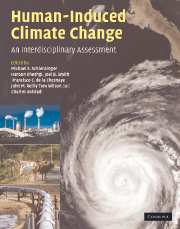Book contents
- Frontmatter
- Contents
- List of contributors
- Preface
- Part I Climate system science
- Part II Impacts and adaptation
- Part III Mitigation of greenhouse gases
- Part IV Policy design and decisionmaking under uncertainty
- 25 Climate policy design under uncertainty
- 26 Climate policy assessment using the Asia–Pacific Integrated Model
- 27 Price, quantity, and technology strategies for climate change policy
- 28 What is the economic value of information about climate thresholds?
- 29 Boiled frogs and path dependency in climate policy decisions
- 30 Article 2 and long-term climate stabilization: methods and models for decisionmaking under uncertainty
- 31 Whither integrated assessment? Reflections from the leading edge
- 32 Moving beyond concentrations: the challenge of limiting temperature change
- 33 International climate policy: approaches to policies and measures, and international coordination and cooperation
- Index
- Plate section
- References
29 - Boiled frogs and path dependency in climate policy decisions
from Part IV - Policy design and decisionmaking under uncertainty
Published online by Cambridge University Press: 06 December 2010
- Frontmatter
- Contents
- List of contributors
- Preface
- Part I Climate system science
- Part II Impacts and adaptation
- Part III Mitigation of greenhouse gases
- Part IV Policy design and decisionmaking under uncertainty
- 25 Climate policy design under uncertainty
- 26 Climate policy assessment using the Asia–Pacific Integrated Model
- 27 Price, quantity, and technology strategies for climate change policy
- 28 What is the economic value of information about climate thresholds?
- 29 Boiled frogs and path dependency in climate policy decisions
- 30 Article 2 and long-term climate stabilization: methods and models for decisionmaking under uncertainty
- 31 Whither integrated assessment? Reflections from the leading edge
- 32 Moving beyond concentrations: the challenge of limiting temperature change
- 33 International climate policy: approaches to policies and measures, and international coordination and cooperation
- Index
- Plate section
- References
Summary
Introduction
Formulating a policy response to the threat of global climate change is one of the most complex public policy challenges of our time. At its core a classic public-good problem, mitigating anthropogenic greenhouse gas emissions is likely to be very costly to any nation that undertakes it, while all would share the benefits. This dynamic creates a temptation to free-ride on others' efforts. This will require coordination among nations and the development of new institutional capacities. The heterogeneity across nations adds complexity; the costs of reducing emissions will not be the same, nor will the benefits of avoiding climate change. Another troubling characteristic is the enormous uncertainty involved, both in the magnitude of future climate change, and therefore the value of avoiding it, and in the costs of reducing emissions. The long timescales of the climate system, decades to centuries, add a final dimension to the policy dilemma. Given the stock nature of greenhouse gases, which build slowly over time, should we delay mitigation activities until some of the uncertainties are reduced? Or wait until technology improves to the point that mitigation is less costly?
We need not decide today on the amount of emissions reductions for all time. Given the degree of uncertainty, it would not make sense. Over time, we will revise the level of policy activities to respond to new information and changing conditions. The relevant question is how much greenhouse gas emissions abatement should be undertaken today.
- Type
- Chapter
- Information
- Human-Induced Climate ChangeAn Interdisciplinary Assessment, pp. 355 - 364Publisher: Cambridge University PressPrint publication year: 2007



